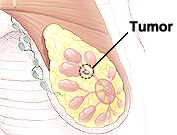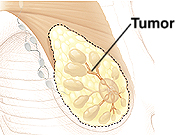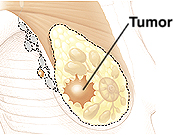Types of Surgery for Breast Cancer
Several surgical procedures are used to treat breast cancer. The goal of each is to remove the cancer. Based on medical factors and your own feelings, you and your surgeon will decide which approach may be best for you.

Lumpectomy
The goal of lumpectomy is to remove the cancer while conserving the breast. To do this, the surgeon removes the breast tissue containing the cancer cells. Some surrounding normal tissue is also taken. This surgery does not often require a hospital stay. In most cases, it is followed by radiation therapy.

Simple Mastectomy
During a simple mastectomy, the surgeon removes all of the breast tissue, plus the nipple. This surgery most often requires a hospital stay. Based on the results of surgery and follow-up tests, further treatment may also be needed.

Modified Radical Mastectomy
During modified radical mastectomy, the surgeon removes all breast tissue. A strip of skin containing the nipple is also taken. Some axillary lymph nodes are removed. This surgery most often requires a hospital stay. Based on the results of follow-up tests, further treatment may be needed.
Risks and Complications
As with any surgery, breast and lymph node surgery involves certain risks:
-
Pain or numbness (under the arm)
-
Bleeding or infection
-
Fluid collection (seroma)
-
Long-term swelling of the arm (lymphedema)
-
Stiffness of the shoulder
Checking the Lymph Nodes
If cancer cells break away from a tumor, they can travel in the lymph fluid. During surgery, your first lymph node or nodes may be identified, removed, and screened for cancer (sentinel node biopsy). Sometimes all of the nodes are removed. If the nodes contain cancer, more treatment is often needed.







